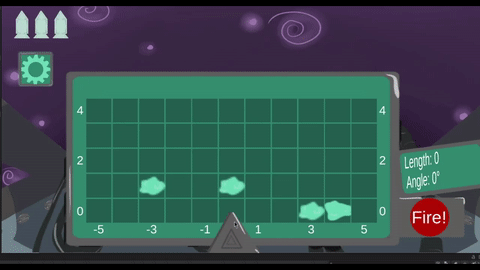Bachelorprojekt SoSe22
Complex Space Adventure
Tired of non-interactive math tutorials? Still, unsure what complex numbers are really used for? Then follow along our complex space adventure and learn how to deal with complex numbers in a playful way. Based on the principles of game-based learning, our complex space adventure prototype teaches you conversions, formulas, and different coordinate systems. Take your chance and become the new complex numbers ace.
Introduction
Who doesn’t enjoy a round of “Battleship”? Inspired by this classic game, we came up with the idea of “shooting” asteroids and alien spaceships. The coordinate system on which “Battleship” is also played offers the perfect opportunity to work with complex numbers and make an entertaining but also educational game out of it. Since mathematics and guessing coordinates, even if done strategically, don’t really go together, we made some modifications. The targets aka asteroids or spaceships are already known in our game, these are eliminated step by step by solving mathematical tasks. With each level, more knowledge about complex numbers will be involved. From simple drag and drop, to calculating the length and angle of a vector/complex number, to practicing the transition between different forms of representation. For this we have developed several functions:
👾 Guide aka Bozee
Bozee is an alien who accompanies you through the story. He helps you complete tasks, supports you when you don’t know the answer, and motivates you when necessary. Bozee is the guide in our game. To make the game engaging and fun, Bozee has been given his own personality. He is very intelligent, can turn back time and sometimes tells a joke. Most students love courses taught by their favorite lecturers. Bozee is meant to be just that: a good professor and at the same time someone who supports you and is a friend to you.
🪐 Level select
The level selection offers a glimpse into the game universe. The player can fly to different planets with the spaceship. The planets build on each other didactically in their complexity of tasks. In the level overview, the player can always determine the exact learning goal and what he can do afterwards. So it is possible for him to always choose the appropriate level.
👣 Continuous build-up of complexity
As mentioned earlier, the game is designed to build upstep by step. It guides the player through different learning objectives in the area of complex numbers. The player can start with little knowledge on the topic of complex numbers and reach a basic understanding of how complex numbers are represented and used by the end of the game.
💬 Motivating user feedback
On the process side, we’ll dive deeper into what we’ve learned about feedback in game-based learning. Feedback is one of the most important components in our game. It provides an opportunity to engage the player, motivate them, and keep them interested in the game and the learning process. Feedback is not only used to tell the player if they did something right or wrong, but rather to motivate them, make them laugh, and thus promote a deeper cognitive learning process.
📱 Use cases
Our target audience are students. A few minutes on the train should be enough to deepen one’s own knowledge about complex numbers. That’s why we decided to develop a prototype for a mobile game that can be played anywhere. A laptop is not necessary to learn something new. It is possible to play the game on a computer during a lecture, for example, but we still focused on using it on a cell phone or tablet. This is because we wanted to make the game as easily accessible as possible.
❔ Help buttons
Whenever you learn something new, you need a guide and the opportunity to try things out. Besides being able to play the levels as many times as needed, the player can also use as many hints as possible. If the player didn’t understand something in the tutorial, there is no barrier to check or expand his knowledge. With the help of the explanations, it is possible for the player to successfully complete a level. In the help section, basic principles are explained once again and old knowledge is refreshed.
Concept
🎮 Basic game idea:
In order to destroy the meteorites, the player goes through different levels(build up on each other introducing each one another subtopic). Step by step the player will learn more about the topic, from simple drag and drop on coordinates/asteroids to finding coordinates in a cartesian or polar coordinate system to transforming complex numbers. Later in the game, the player also encounters alien spaceships, to “outsmart” their technology, more components such as frequencies and curves are added. Didactically, these then form the transition from the mathematical to the electro technical view point in later levels.
👣 General steps per level:
A signal for a meteor/enemy spaceship is received
The player is instructed by his alien companion
The player calculates the flight curve of the rocket to destroy the asteroid
Later, e.g. frequencies have to be adjusted mathematically or visually to other curves
The “Fire” button gets pressed, and the player receives direct feedback.
🛸 We decided to focus on the first three levels
In level 1️⃣, the asteroids appear on your cockpit display and the player drags and drops to adjust the route so that an arrow points to the asteroid. The length of the arrow and the angle are displayed on the side. A simulation shows the path of the rocket. If the alignment is correct, the asteroid will be destroyed.
LEARNING GOAL: according to Bloom’s Taxonomy (Understand and memorize): the player identifies the path aka vector of the complex number and memorizes that it has a length and angle.

In level 2️⃣ new asteroids are on their way! Their are a lot of them but……what happened? The display now no longer shows asteroids! The player only gets coordinates and has to determine the point himself.
LEARNING GOAL: according to Bloom’s Taxonomy (Understand and apply): the player locates the position of the asteroid in the coordinate system and uses previous knowledge to find the right field.

In level 3️⃣ the drop-assisted aim module of the spaceship does not work anymore, so the player has to calculate the amplitude/length as well as the angle.
LEARNING GOAL: according to Bloom’s Taxonomy(apply): the player solves the necessary equations to calculate the length and angle which are needed for the transformation from cartesian to euler coordinates.

Team
- Robert Sourmenelian
- Richard Seidel
- Nina Weddige
- Jana El Mouaied El Azm
- Nell Ehrlinger
Betreuung
Martin Steinicke, Adrian Sabrowski
Links
https://showtime.f4.htw-berlin.de/ss22/bachelor/b3-e-learning-komplexer-zahlen
